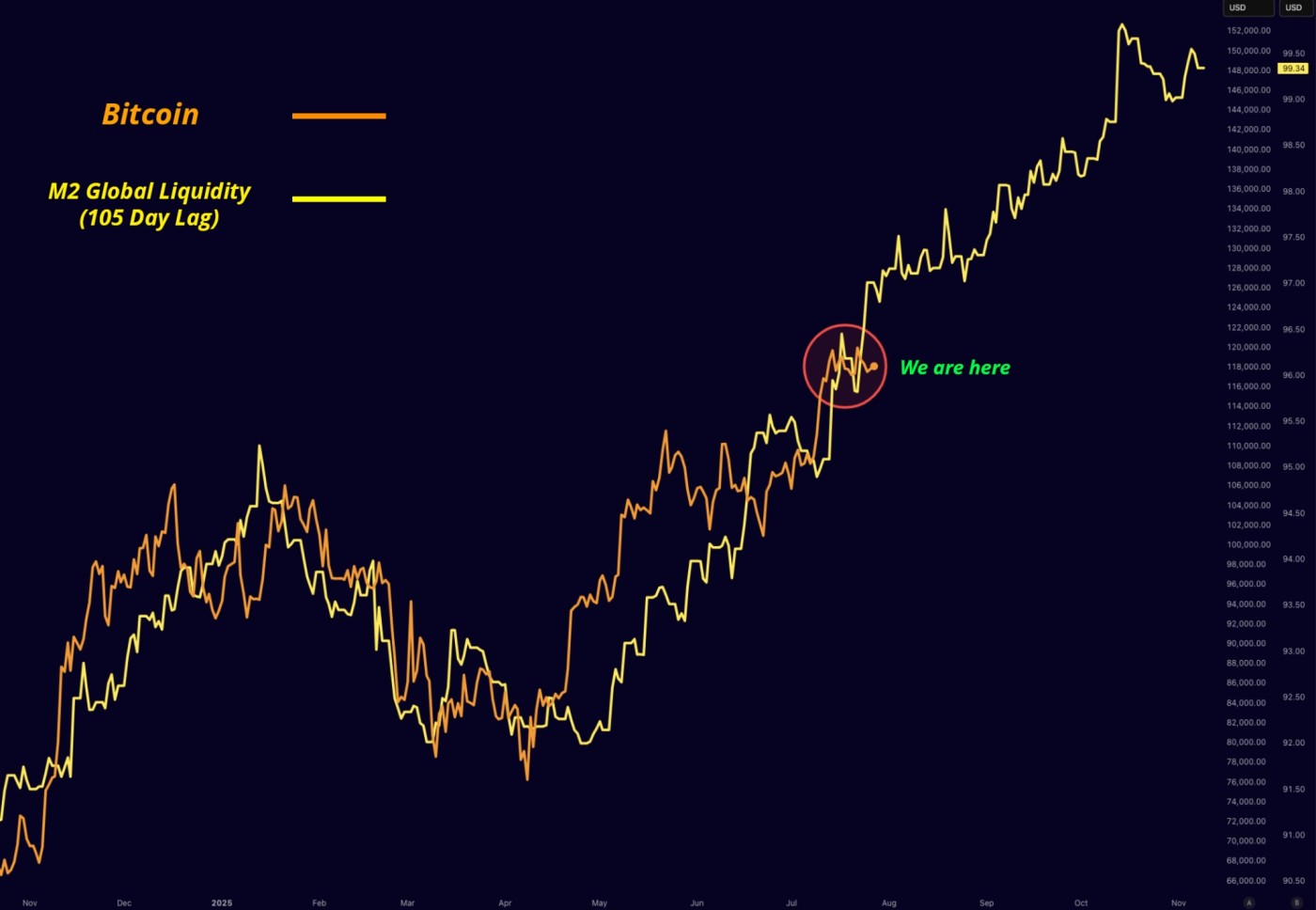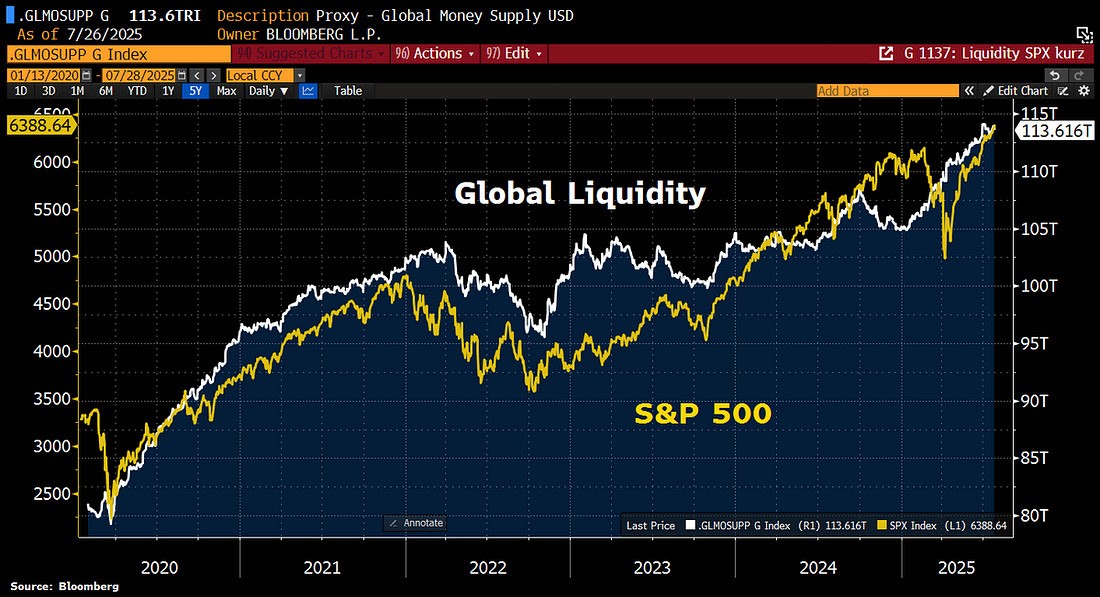by Dr. Chris Kacher
Tariffs spur global liquidity
President Trump claims to have won a significant trade deal with the European Union where:
The EU agreed to buy hundreds of billions of dollars in US military equipment but the European Commission explicitly denied committing to any such amount.
The EU agreed to make $600 billion in investments in the US though this is largely not a new pledge.
The EU agreed to buy $750 billion of US energy. However, this is not a firm, enforceable contract.
Other countries may follow suit by directing large capital investments in the US. So each trade deal brings higher certainty that global liquidity will continue to expand, which means stocks and Bitcoin are going higher.
Liquid asset prices have a structural tailwind, and trade deals are merely adding fuel to that fire. M2 Money Supply is soaring. Bitcoin will follow. Bitcoin tends to lag global liquidity by roughly 105 days, give or take.

Stocks also highly correlate with global liquidity. Without the 105 day delay, there is still a strong correlation. Notice how the S&P 500 that got pulled down in a hurry by Trump's tariff news shock in April 2025 but then hurriedly caught up. Notice also how the S&P 500 peaks at the end of 2021, a few weeks before we sent out emails to members about heading to cash after Powell announced in November 2021 that he would have to start tightening.

As for GDP which came in well above estimates at 3%, we have now seen 63 months of US economic expansion, the 7th longest business cycle since 1854. By comparison, the longest period without a recession was between 2008 and 2020 at 125 months after QE was launched. Indeed, the market has structurally changed by the central bank’s willingness to print money and dropping interest rates to historically low levels during crises, both which materially debase fiat. This spurs global liquidity.
Nailing Bitcoin's major tops and bottomsEarlier this year, I issued one of my rare, major buy signals for Bitcoin and related vehicles in stocks such as MSTR and GBTC. This run will likely lead to an epic, climax top within the next 6–12 months; history is unequivocal on this. The setup right now points to Bitcoin spiking as high as $400,000–$500,000 in this current cycle. That kind of action means Ethereum breaking well above $10,000 is not just possible, it’s likely.
In consequence, the current Bitcoin bull will likely lead to an epic, climax top within the next 6–12 months; history is unequivocal on this. The setup right now points to Bitcoin spiking as high as $400,000–$500,000 in this current cycle. That kind of action means Ethereum breaking well above $10,000 is not just possible, it’s likely.
Global liquidity remains the key driver, and the deep correlation between that liquidity, BTC, and ETH is no theory; my research paper lays it out in black and white. Should this wave keep building due to institutional involvement, we could even witness Bitcoin breaching $1 million and Ethereum hitting $25-50,000 in this cycle.
This means the highest alpha stock ETFs such as TECL and TQQQ should also continue their long term uptrends, until we get a warning that global liquidity will slow. Tightening seems distant given the structural defects of the global financial system that supports fractional banking and central banks.
If you haven't already, now is the time to seize this generational opportunity. Bitcoin has offered such buying opportunities for many years, outside of its bear markets which tend to go a year or less, but for those who have asked if it is too late, there is likely more time in the current cycle, black swans notwithstanding.
QEndless
Since the great financial crisis of 2008, every economic upheaval has been met not with true reform, but with quantitative easing where central banks flood the system with money to roll over mountains of debt. This isn’t about traditional growth or productivity; it’s about refinancing, again and again, as a massive 5-6 year cycle of global liquidity swells and recedes in sync with waves of maturing debt. It is these refinancing pressures, not old-fashioned metrics like debt-to-GDP, that now control the markets.
The true engine of markets today is monetary inflation, unleashed by relentless liquidity growth that steadily erodes the value of every unit of fiat currency. This hidden force inflates the prices of real assets—stocks, gold, and, most strikingly, bitcoin. Over time, as the tide of liquidity rises, so do these assets. Look at bitcoin: despite its early wild swings, its volatility is fading as the asset matures. Since its birth in 2009, bitcoin has become the clearest real-time gauge of how inflation, fueled by global liquidity, silently destroys the buying power of money.
Meanwhile, public debt is exploding at a rate outpacing private debt, driven by the crushing weight of unfunded promises—pensions, retirement accounts—and ballooning interest burdens. The machinery of central banking is now forced to keep expanding liquidity just to keep up. Debt creates the appetite and the need for more money, while that very liquidity pushes asset prices higher and higher. Gold, up more than twelvefold since 2000, and bitcoin, rising even more spectacularly, aren’t just investments; they are vital lifeboats against the storm of monetary inflation.
Make no mistake: It doesn’t matter who occupies the highest office. The devaluation of fiat is not a matter of “if,” but “how fast.” When Nixon severed the dollar from the gold standard, he handed central banks unchecked power to print money, set interest rates, and battle crises on their own terms. Quantitative easing, unthinkable under a gold-backed system, has become the tool of choice ever since 2008.
Today, global markets revolve around refinancing old debts, not funding new growth. It is liquidity, not interest rates, that now moves markets. And as daunting debt maturities loom, such as the massive wall coming in mid-2025, central banks will be pressed to create even more money. This is why the global liquidity cycle pulses every 65 months because we are always racing to refinance yesterday’s promises.
With global debt already at record highs, just the interest payments force the creation of ever more digital money. If this cycle continues to accelerate, so too will the devaluation of our currencies. We can only hope we avoid the fate of countries that have gone too far because, if we are not careful, the world could stumble down the same tragic path of runaway inflation.
One thing seems inevitable: Stocks, Bitcoin, real estate, and other hard assets will continue higher overall with the occasional sharp corrections until the financial big bang which may still be years off due to productivity created by AI.
